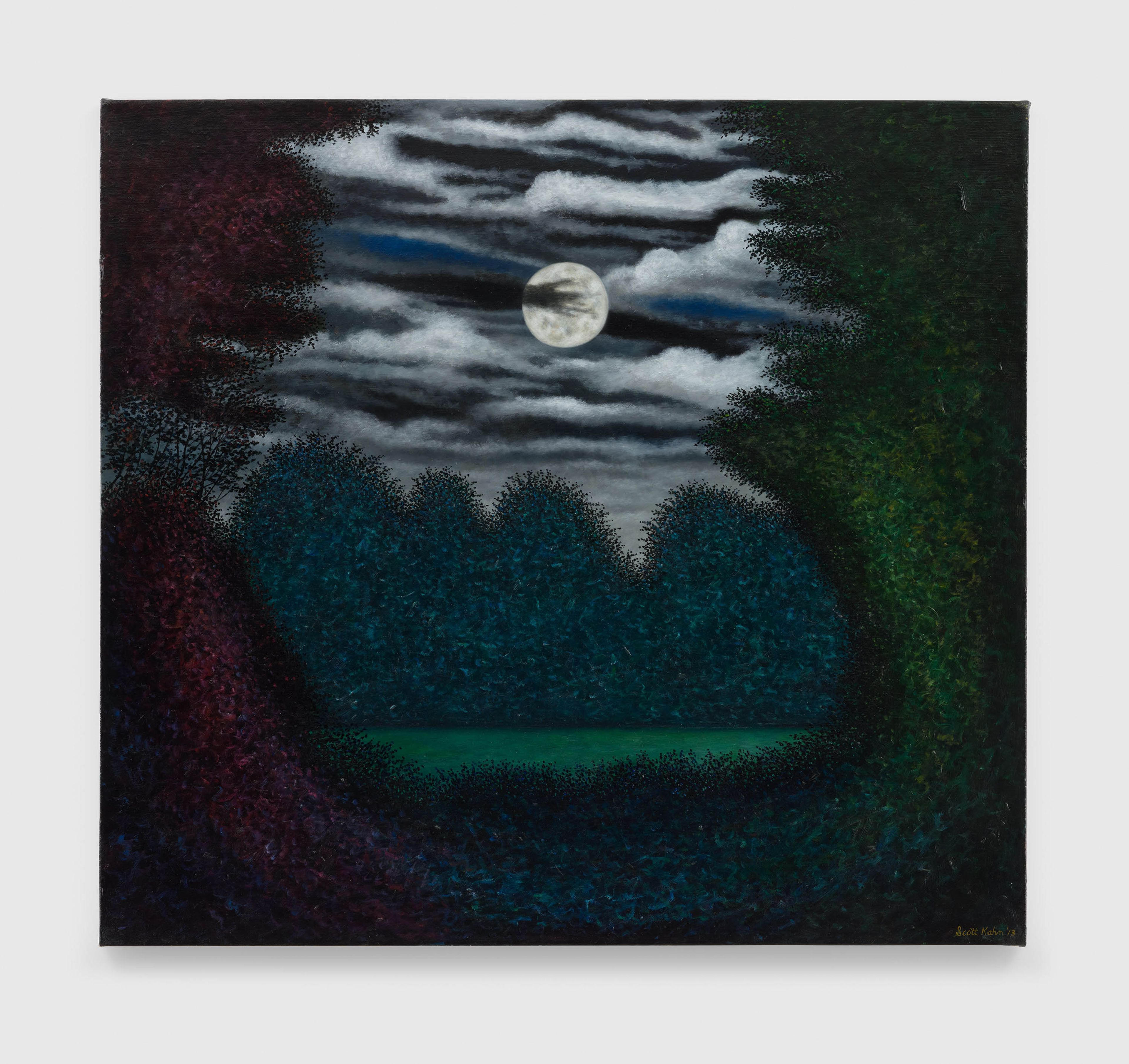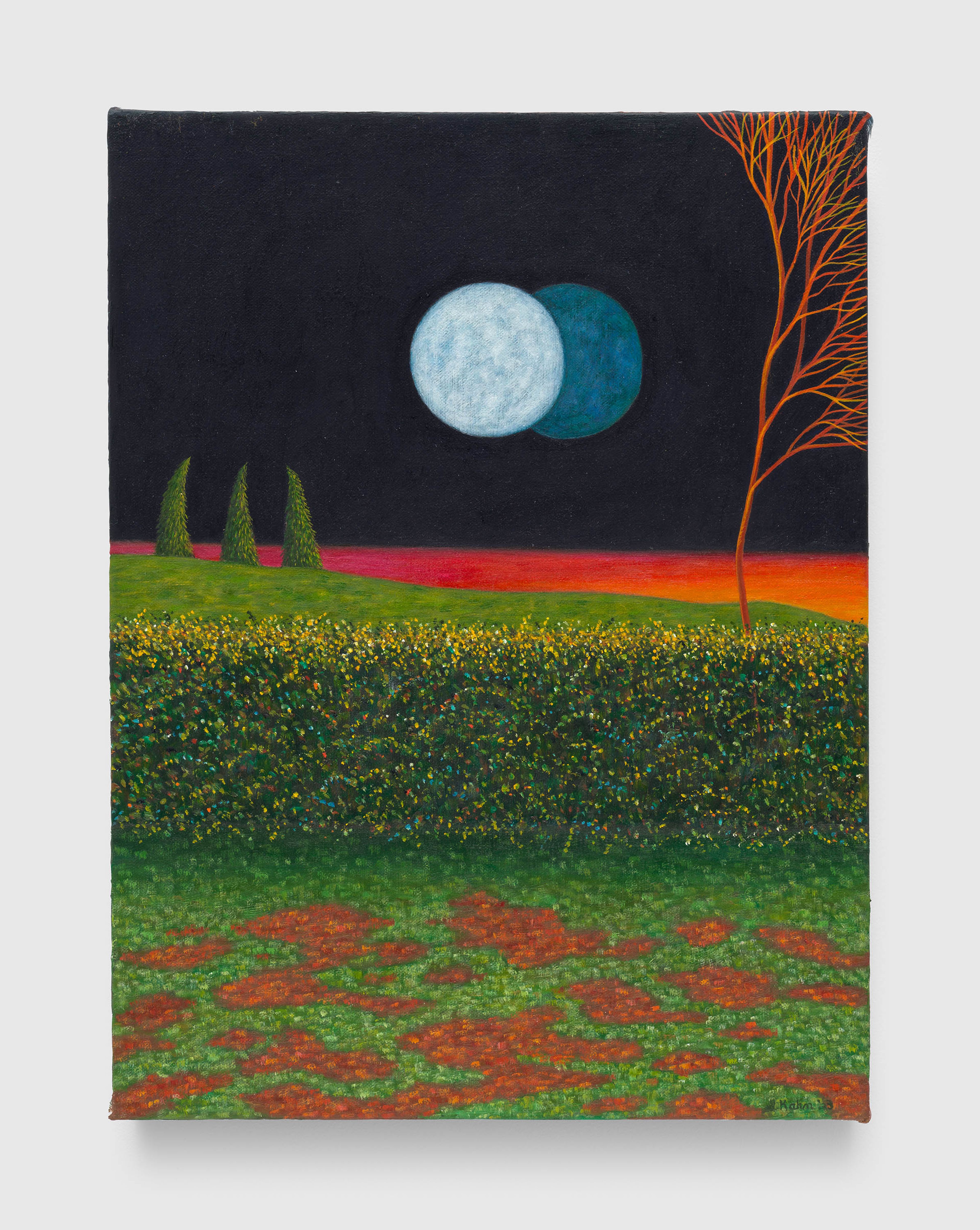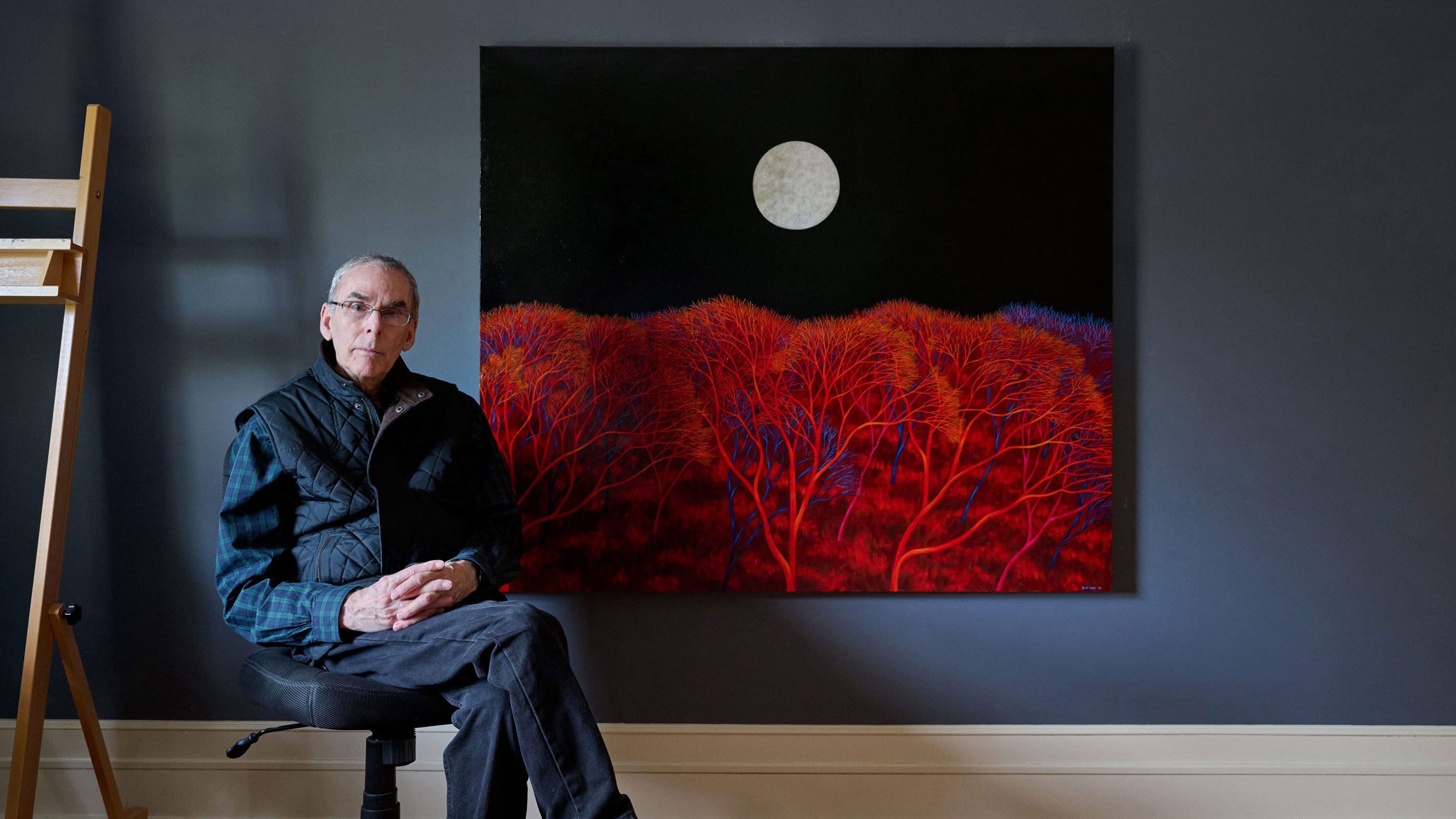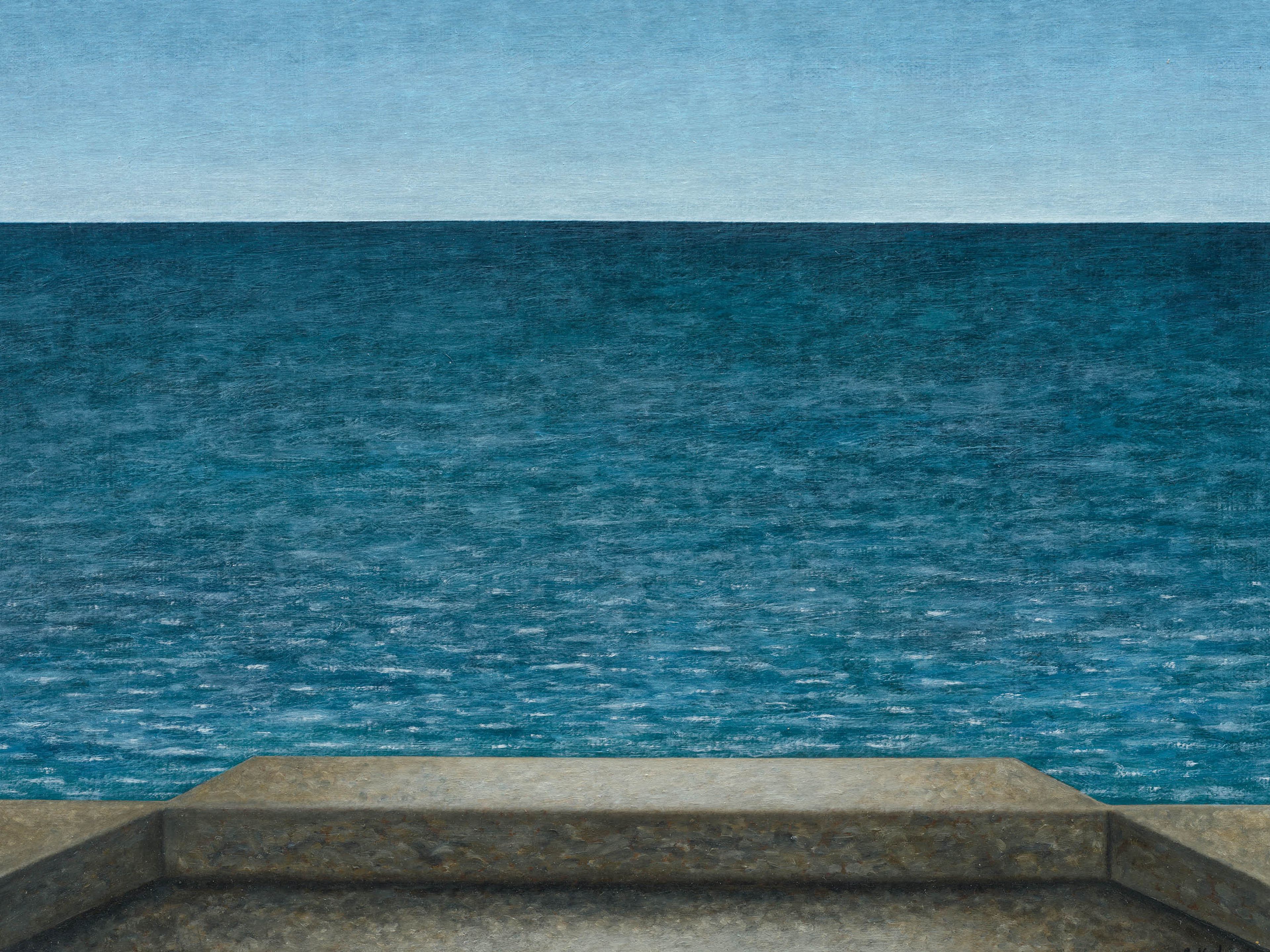Scott Kahn’s Inimitable Views
By John Yau
The first two observations I want to make about Scott Kahn’s paintings are that they are immediately recognizable and that they don’t look like anyone else’s work. This means they occupy a place all their own within the diverse landscape of painting. While this is an accomplishment in and of itself, Kahn’s work is more than its style. Originating with something the artist has experienced, the paintings exceed their realism and seamlessly attain a heightened clarity akin to a hypnagogic state. Standing before a painting by Kahn, we begin to see ourselves seeing a world, which, despite its plethora of precise details, remains a mystery, like a beautiful box that cannot be opened up. This quality is what holds my attention, surfaces in my memory, and pulls me into the scene.
Kahn belongs to that rare group of artists who, one day, leave the comfort of being connected to a category to pursue a trajectory that separates them from their contemporaries. In order to effect this change, Kahn, who was for many years an abstract artist, had to teach himself how to connect what he was doing with what he was seeing. When, in a recent interview, he was asked about this change, Kahn said:
I wondered: where do I begin? I started from myself! The first painting from life was a self-portrait. It was a small painting, it was an abstract painting originally, but I painted over it. Then I moved, and I started with landscapes. It has been four years where I taught myself to paint from life. I wanted to paint everything: I painted the interiors of the tiny apartment I had when the weather wasn’t good, I painted portraits, I asked the woman who was living downstairs to sit for a portrait, I painted all the traditional subject matters, but I was obsessive, I painted every leaf as I saw it as accurately as I could.… I was painting from observation.… I moved again, and a new period started; I painted in my studio, and there were no trees, no landscapes out the windows, there was NY. So I began to rely on my memory and imagination, which was the beginning of really finding my new voice.1
In the eight landscape paintings gathered for this exhibition, we see where Kahn has arrived, which is unique among American painters and––dare I say––the global art world. In Spring Moon (2013), Kahn frames the view of a full moon in a cloud-streaked night sky. On the right side of the painting, extending in from the edge, is a largely green, stippled, wild hedge that spans from the top to the bottom. On the left side is a dark magenta-hued, stippled hedge that also stretches from the top to bottom edge, but with an opening made of a few almost bare branches that one can peer through. The edges of each hedge are irregular.

Scott Kahn, Spring Moon, 2013
Here is where we see evidence of Kahn’s prismatic mastery: the magenta hue is the spectral complement of green. The painting engages us on different physical and mental levels, from the optical to the self-reflective. In this regard, form cannot be separated from content, or subject matter from its visual realization.
A black cloud (or is it a shadow?) that appears to be moving from left to right partially covers the full moon, which floats in front of the rest of the clouds. With its palm and fingerlike appendages, the black shape resembles a hand. Once we make this association, we can neither get it out of our mind, nor can we decipher its meaning. This resistance to narrative is remarkable considering the view is crystalline in its specificity. We are standing, looking at a partially obscured full moon. The scene is ominous and calm. A low hedge is in front of us, the first barrier blocking our passage. A row of four large blue-green bushes of varying heights, each culminating in a rounded point, is ahead of us, across a field of emerald-green grass. The hedges lean to the left, as if succumbing to a wind whose force seems to only affect them. Visually, they act in rhythmic counterpoint to the hand, which appears to move in the opposite direction. The unharmonious world is constantly undergoing change.
Two moons float in the black sky of Blue Moon II (2023). We are standing on green grass covered with irregularly shaped areas of brown. Directly in front of us, a row of green hedges stippled with yellow and blue flowers spans the width of the painting, blocking our way forward. A field of green grass lies beyond the hedges, with three conical trees visible on the left, rising from behind the grass’s slightly slanting edge. Beyond that is a glowing, featureless, slightly gradated red plane, which forms the horizon beneath a black starless sky occupied by two full moons. The white full moon partially covers the blue full moon behind it. On the painting’s right side is a thin, curving red tree with bare branches. The vastness of the sky is unsettling because there are no stars in it, no sign that we are not alone.

Scott Kahn, Blue Moon II, 2023
Each area of the work, from the grass in front of the hedge row to what lies beyond it, is painted differently from the others. By making each area distinct, Kahn underscores the varying textures and appearances of things found in nature, reminding us that reality is full of unique entities in a state of permanent collision. As with Spring Moon there is something which cannot be identified in the painting. What is the red area? Is it a solid plane, lava, or water? This unidentifiable part of the painting can be understood in two ways. First, by making it elusive to naming the artist reminds us that we don’t have dominion over nature and cannot name every part of it––this implies ownership. Second, its incongruous presence infuses the scene with inexplicable mystery.
Our inability to name all the parts of a painting by Kahn is the result of the visual lucidity of each part. This is what is unexpected and compelling about the work. We find ourselves in a world lit by a logic all its own. Because its coherence supersedes its incongruities, the scene makes sense in a way only a painting can achieve. Often defined as dreamlike, Kahn’s paintings are more than that. The only artist I find him comparable to is Vincent van Gogh, whose brushstrokes are completely different from Kahn’s. That difference is crucial, as it requires that we learn to see Kahn’s paintings for what they are. Not a member of any group or movement, Kahn is indeed that rare, one-of-a-kind artist who brings us news from a reality that lies just beyond comprehensibility, but which we know is real.
Notes
1 Scott Kahn, interview by RDN Arts, June 2, 2021, https://rdnarts.com/articles/interviews-we-love-scott-kahn/.
斯科特·卡恩獨一無二的視界
姚強
關於斯科特·卡恩的繪畫,我有兩個最直觀的觀察:它們一眼就能被辨識出,看起來和其他任何人的作品都不一樣。這意味着,它們在紛繁多樣的繪畫領域中占據着一席之地。雖然這本身已是一項成就,但卡恩的作品不僅限於其風格。這些繪畫源自藝術家的親身經歷,但它們超越其自身的現實,無縫達成了一種類似於催眠狀態的高清晰度。站在卡恩的繪畫前,我們看到自己正在觀看一個世界,其中盡管飽含大量精確的細節,但仍舊是個謎,就像一個無法被打開的美麗的盒子。正是這種特質吸引了我的注意力,浮現於我的記憶裏,並將我拉入場景之中。
卡恩屬於這樣一類罕見的藝術家——有一天,他們會離開與某個創作類別相關聯的舒適區,去追尋一條與同時代人不同的軌跡。為了實現這樣的轉變,多年來一直是抽象藝術家的卡恩,必須自學如何將他所做的創作與眼見的事物關聯起來。在最近一次采訪中,當他被問及這一轉變時,卡恩說道:
我心想:該從哪兒開始呢?就從我自己開始!第一幅寫生作品是一幅自畫像。那是一張小畫,起初是幅抽象畫,但我直接把畫改了。之後我搬了家,開始畫風景。我自學繪畫寫生已經有四年。我想要畫下一切:天氣不好時,我就畫自己那間小公寓的室內;我也畫肖像,請住在樓下的女人做我的模特;我畫過所有的傳統題材,但我癡迷於此,我盡可能準確地描繪每一片樹葉……我依據觀察來繪畫……我後來又搬家了,開啟了一個全新的創作階段。我可以在自己的工作室裏畫畫,窗外沒有樹、沒有風景,只有紐約。於是我開始憑藉自己的記憶和想象來畫,這是我真正找到新風格的開始。【1】
在此次展覽匯集的八幅風景繪畫中,我們可以看到卡恩的創作達到了怎樣的境界,他的作品在美國畫家——乃至全球的藝術界中,都是獨樹一幟的。在《春月》(2013)中,卡恩將一輪滿月置於雲霧繚繞的夜空裏。在畫面的右側,從邊緣延伸出一片以綠色為主、點彩畫般的野生樹籬,從頂部一直延伸到底部。左側,則是一片暗啞、品紅色的點彩樹籬,同樣從頂部延伸到底部,但有一處由幾根幾乎光禿的樹枝組成的開口,讓觀眾得以向內張望。每道樹籬的邊緣都不規則。
在這裏,我們看到了卡恩對色彩的精湛運用:品紅色與綠色在光譜上互補。從視覺到自我反思,這幅畫從不同的物質與精神層面吸引着我們。在這方面來說,形式不能與內容相分割,正如主體不能與其視覺之實現分離。
一朵烏雲(也許是一縷陰影?)好像從左至右移動着,部分遮住了浮在雲層前的滿月。黑色的形態好像手掌和附屬的手指,形成一只手。一旦我們有了這樣的聯想,就無法將其從腦海中抹去,也無法解讀其含義。這種對敘述的抵抗是顯著的,尤其是畫面在其特定性上清晰如水晶。我們站着,看一輪局部被遮擋的滿月。這幕場景既不祥又平靜。一道低矮的樹籬擋在我們面前,這是阻擋我們向前行進的第一道屏障。四團高矮各異的藍綠色大灌木叢連成一排,每棵灌木叢的頂部都是圓形的,它們在我們前方,位於一片翠綠的草地前。樹籬向左傾斜,仿佛屈服於一股只對它們施加影響的強風。從視覺上看,它們與那只手形成了有律動的對比,而手似乎在朝着相反的方向移動。並不和諧的世界在不斷地變化着。
《藍月II》(2023)中,兩輪月亮懸浮在黑色的天空中。我們站在布滿了不規則褐色區塊的綠草地上。在我們正前方,一排點綴着黃色和藍色花朵的綠色樹籬橫跨整幅畫面,擋住了我們的去路。樹籬後面是一片綠草,左側有三棵圓錐形的樹,從草地略微傾斜的邊緣後升起。再往遠處,是一片發光的、毫無特征的漸變的紅色平面,它在了無星光卻掛着兩輪滿月的黑色夜空下方,構成了地平線。那輪白色滿月的局部遮住了其後的藍色滿月。畫面右側,是一棵細長而彎曲的紅樹,樹幹光禿禿的。天空的開闊令人不安,因為沒有星星,沒有跡象表明我們並非孤立。
從樹籬前的草地到更遠處的景致,畫面的每個區塊都采用了不同的繪畫手法。卡恩讓其各不相同,以此強調了自然界中各種事物的不同紋理及外觀,提醒我們現實世界充滿了處於永久碰撞狀態的獨特存在。與《春月》一樣,畫面中有一些無法被辨識的事物。那個紅色的區塊是什麽?是堅實的平面、熔岩還是水?無法辨識的部分有兩種方式來理解。首先,它們難以命名,藝術家以此提醒我們,我們並不能支配自然,無法對其每個部分進行命名——而這意味着所有權。第二,其不協調的存在為場景注入了難以解釋的神秘感。
我們無法命名卡恩繪畫中的每個部分,這是因為各個部分都清晰可見。這正是作品出人意料並引人入勝的地方。我們發現自己身處一個由其自身邏輯所照亮的世界。由於連貫性超越了不協調性,場景以一種只有繪畫才能實現的方式凸顯意義。卡恩的繪畫常被定義為如夢如幻,但它們遠不止如此。我發現唯一能與他相提並論的藝術家是文森特·梵高(Vincent van Gogh),盡管梵高的筆觸與卡恩的全然不同。這樣的差異至關重要,因為它要求我們學着去看到卡恩繪畫的本質。卡恩不屬於任何團體或流派,他的確是一位罕見的獨一無二的藝術家,他為我們帶來了某種超出我們理解範疇的現實的新聞,但我們知道它是真實的。
腳注:
【1】斯科特·卡恩,引語出自《RDN 藝術》的訪談,2021年6月2日,https://rdnarts.com/articles/interviews-we-love-scott-kahn/。

